Taxation Law Assignment: CGT, Income, and Loan Scenarios Analysis
VerifiedAdded on 2023/03/30
|8
|2282
|466
Homework Assignment
AI Summary
This taxation law assignment presents solutions to three questions. The first question examines capital gains tax (CGT) implications for various assets, including an antique painting, historical sculpture, antique jewelry, and a picture, considering pre-CGT assets, collectables, and personal use assets. The second question addresses the tax consequences of payments received for services, analyzing whether payments for writing a book, assigning copyright, and selling manuscripts constitute taxable income from personal exertion, referencing relevant case law. The third question discusses the tax treatment of interest received from a loan, determining whether a one-off interest payment constitutes income, and referencing case law to support the analysis. The assignment provides a comprehensive analysis of relevant tax concepts and principles.
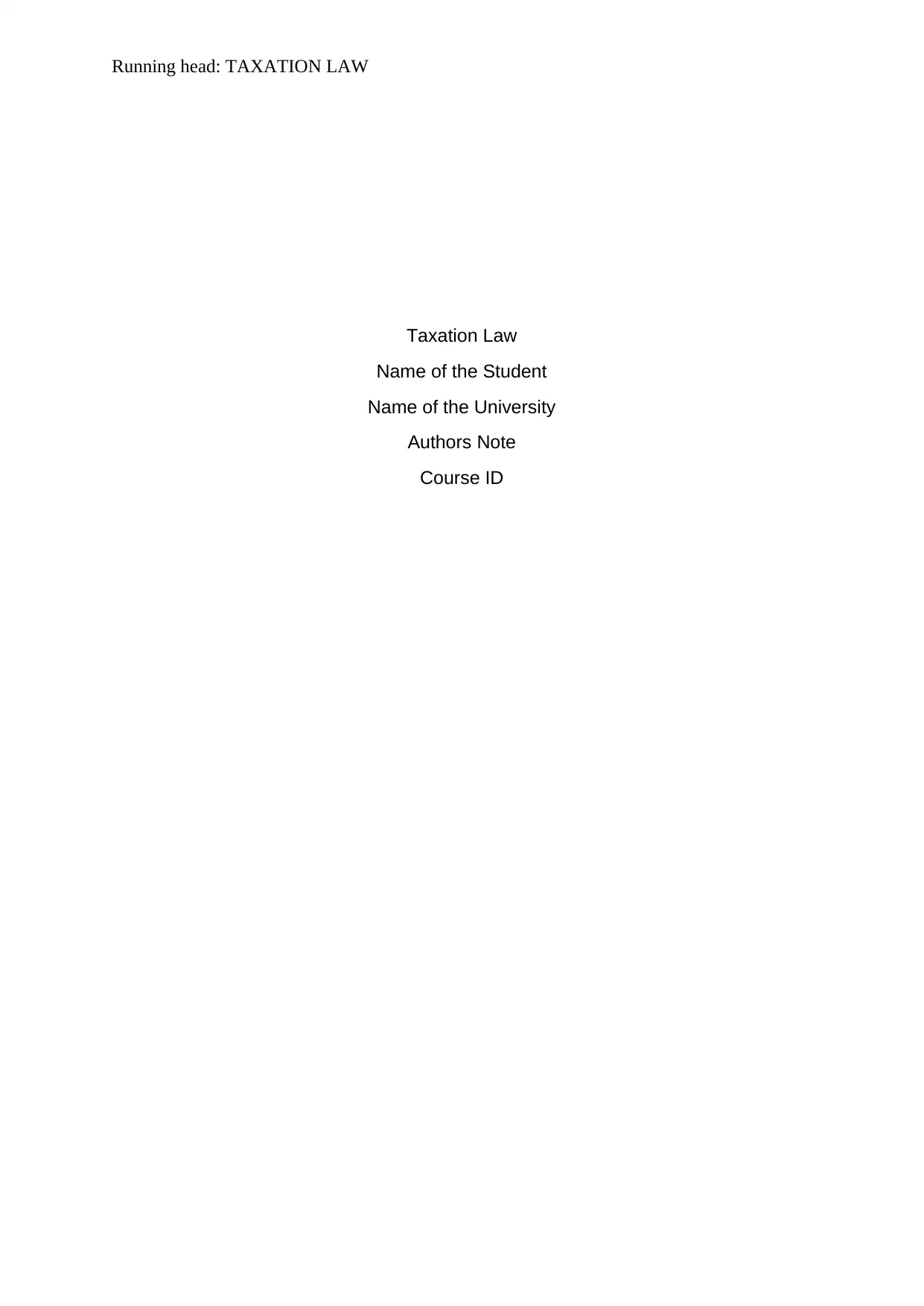
Running head: TAXATION LAW
Taxation Law
Name of the Student
Name of the University
Authors Note
Course ID
Taxation Law
Name of the Student
Name of the University
Authors Note
Course ID
Paraphrase This Document
Need a fresh take? Get an instant paraphrase of this document with our AI Paraphraser
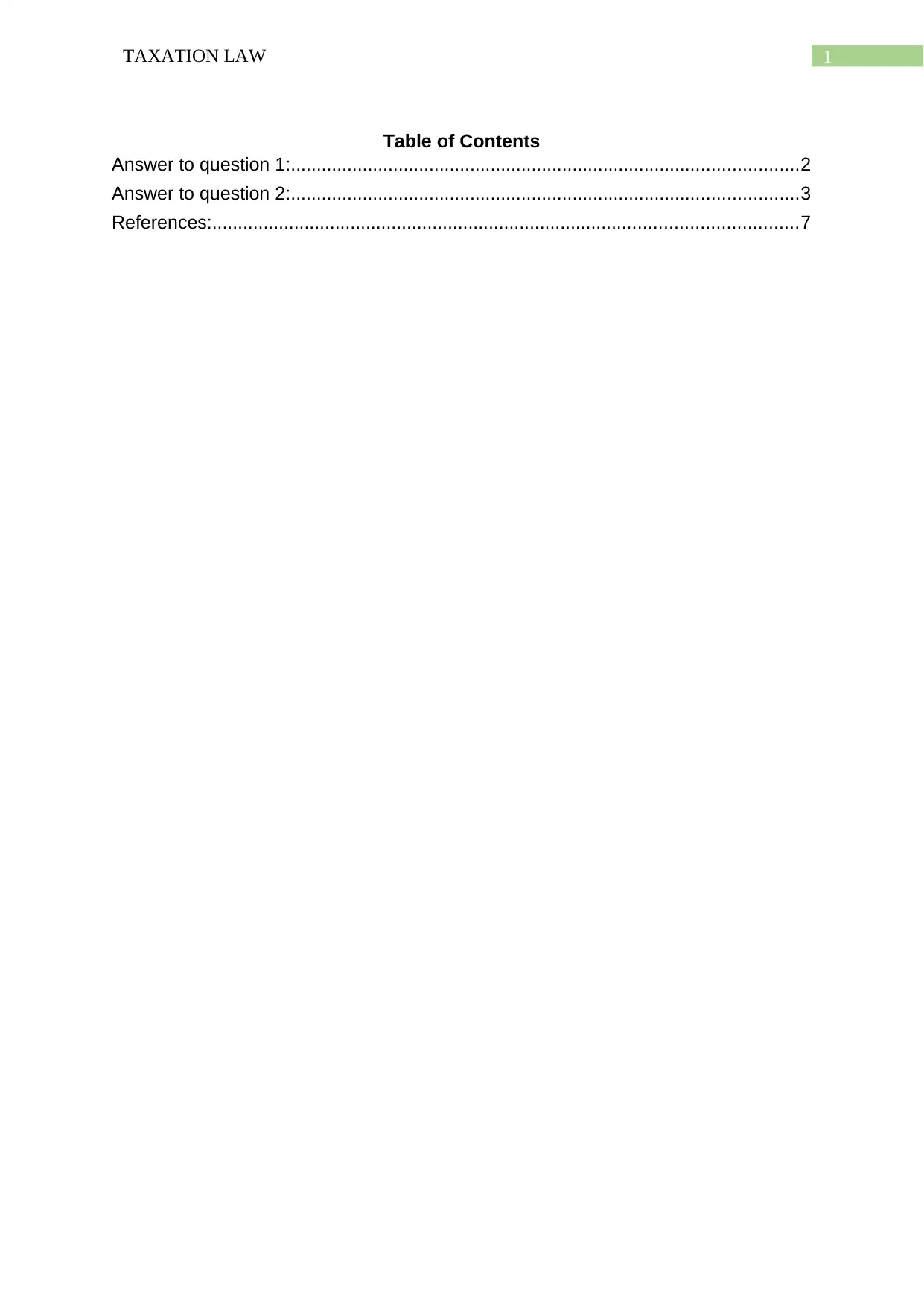
1TAXATION LAW
Table of Contents
Answer to question 1:...................................................................................................2
Answer to question 2:...................................................................................................3
References:..................................................................................................................7
Table of Contents
Answer to question 1:...................................................................................................2
Answer to question 2:...................................................................................................3
References:..................................................................................................................7
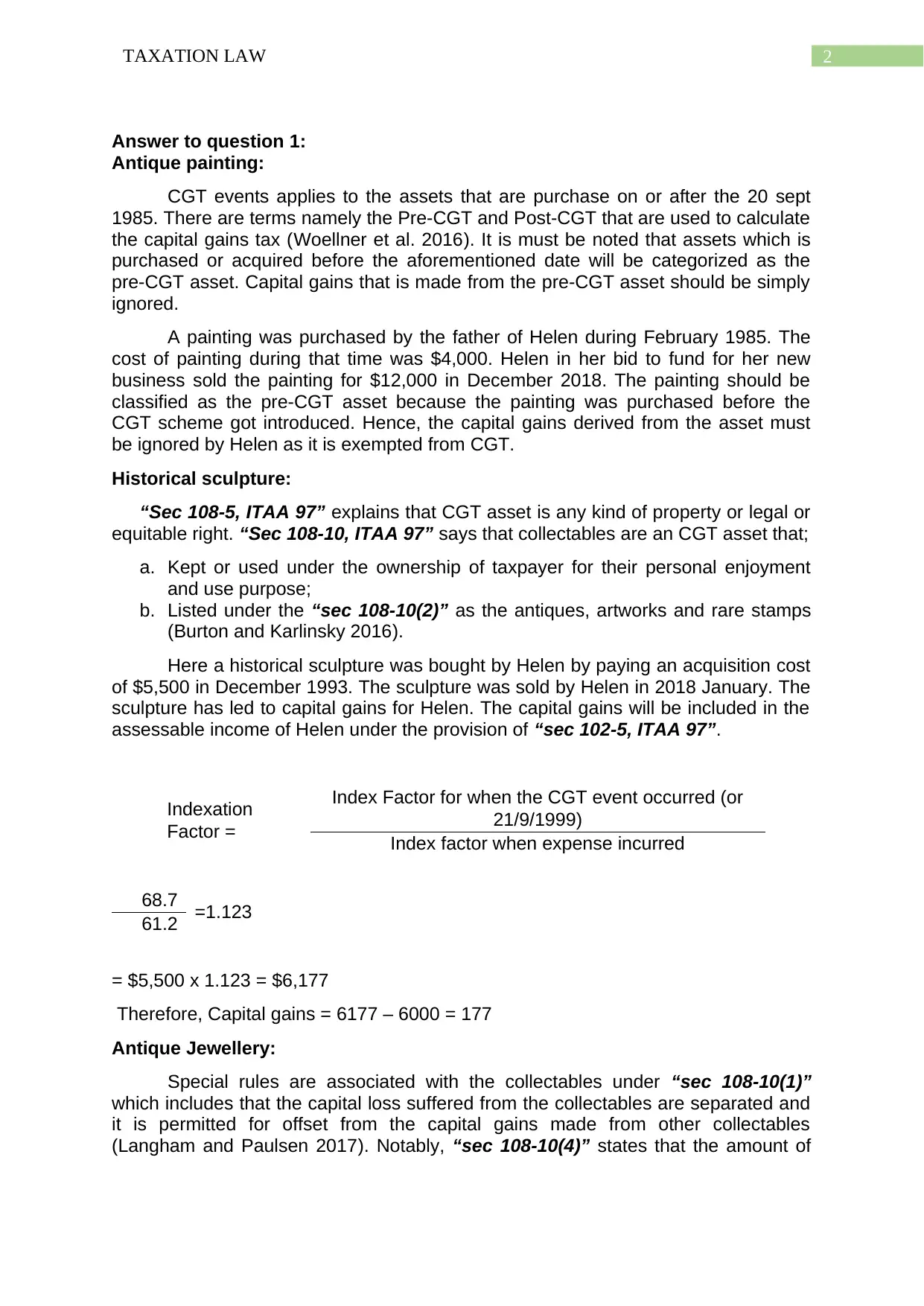
2TAXATION LAW
Answer to question 1:
Antique painting:
CGT events applies to the assets that are purchase on or after the 20 sept
1985. There are terms namely the Pre-CGT and Post-CGT that are used to calculate
the capital gains tax (Woellner et al. 2016). It is must be noted that assets which is
purchased or acquired before the aforementioned date will be categorized as the
pre-CGT asset. Capital gains that is made from the pre-CGT asset should be simply
ignored.
A painting was purchased by the father of Helen during February 1985. The
cost of painting during that time was $4,000. Helen in her bid to fund for her new
business sold the painting for $12,000 in December 2018. The painting should be
classified as the pre-CGT asset because the painting was purchased before the
CGT scheme got introduced. Hence, the capital gains derived from the asset must
be ignored by Helen as it is exempted from CGT.
Historical sculpture:
“Sec 108-5, ITAA 97” explains that CGT asset is any kind of property or legal or
equitable right. “Sec 108-10, ITAA 97” says that collectables are an CGT asset that;
a. Kept or used under the ownership of taxpayer for their personal enjoyment
and use purpose;
b. Listed under the “sec 108-10(2)” as the antiques, artworks and rare stamps
(Burton and Karlinsky 2016).
Here a historical sculpture was bought by Helen by paying an acquisition cost
of $5,500 in December 1993. The sculpture was sold by Helen in 2018 January. The
sculpture has led to capital gains for Helen. The capital gains will be included in the
assessable income of Helen under the provision of “sec 102-5, ITAA 97”.
Indexation
Factor =
Index Factor for when the CGT event occurred (or
21/9/1999)
Index factor when expense incurred
68.7 =1.123
61.2
= $5,500 x 1.123 = $6,177
Therefore, Capital gains = 6177 – 6000 = 177
Antique Jewellery:
Special rules are associated with the collectables under “sec 108-10(1)”
which includes that the capital loss suffered from the collectables are separated and
it is permitted for offset from the capital gains made from other collectables
(Langham and Paulsen 2017). Notably, “sec 108-10(4)” states that the amount of
Answer to question 1:
Antique painting:
CGT events applies to the assets that are purchase on or after the 20 sept
1985. There are terms namely the Pre-CGT and Post-CGT that are used to calculate
the capital gains tax (Woellner et al. 2016). It is must be noted that assets which is
purchased or acquired before the aforementioned date will be categorized as the
pre-CGT asset. Capital gains that is made from the pre-CGT asset should be simply
ignored.
A painting was purchased by the father of Helen during February 1985. The
cost of painting during that time was $4,000. Helen in her bid to fund for her new
business sold the painting for $12,000 in December 2018. The painting should be
classified as the pre-CGT asset because the painting was purchased before the
CGT scheme got introduced. Hence, the capital gains derived from the asset must
be ignored by Helen as it is exempted from CGT.
Historical sculpture:
“Sec 108-5, ITAA 97” explains that CGT asset is any kind of property or legal or
equitable right. “Sec 108-10, ITAA 97” says that collectables are an CGT asset that;
a. Kept or used under the ownership of taxpayer for their personal enjoyment
and use purpose;
b. Listed under the “sec 108-10(2)” as the antiques, artworks and rare stamps
(Burton and Karlinsky 2016).
Here a historical sculpture was bought by Helen by paying an acquisition cost
of $5,500 in December 1993. The sculpture was sold by Helen in 2018 January. The
sculpture has led to capital gains for Helen. The capital gains will be included in the
assessable income of Helen under the provision of “sec 102-5, ITAA 97”.
Indexation
Factor =
Index Factor for when the CGT event occurred (or
21/9/1999)
Index factor when expense incurred
68.7 =1.123
61.2
= $5,500 x 1.123 = $6,177
Therefore, Capital gains = 6177 – 6000 = 177
Antique Jewellery:
Special rules are associated with the collectables under “sec 108-10(1)”
which includes that the capital loss suffered from the collectables are separated and
it is permitted for offset from the capital gains made from other collectables
(Langham and Paulsen 2017). Notably, “sec 108-10(4)” states that the amount of
⊘ This is a preview!⊘
Do you want full access?
Subscribe today to unlock all pages.

Trusted by 1+ million students worldwide
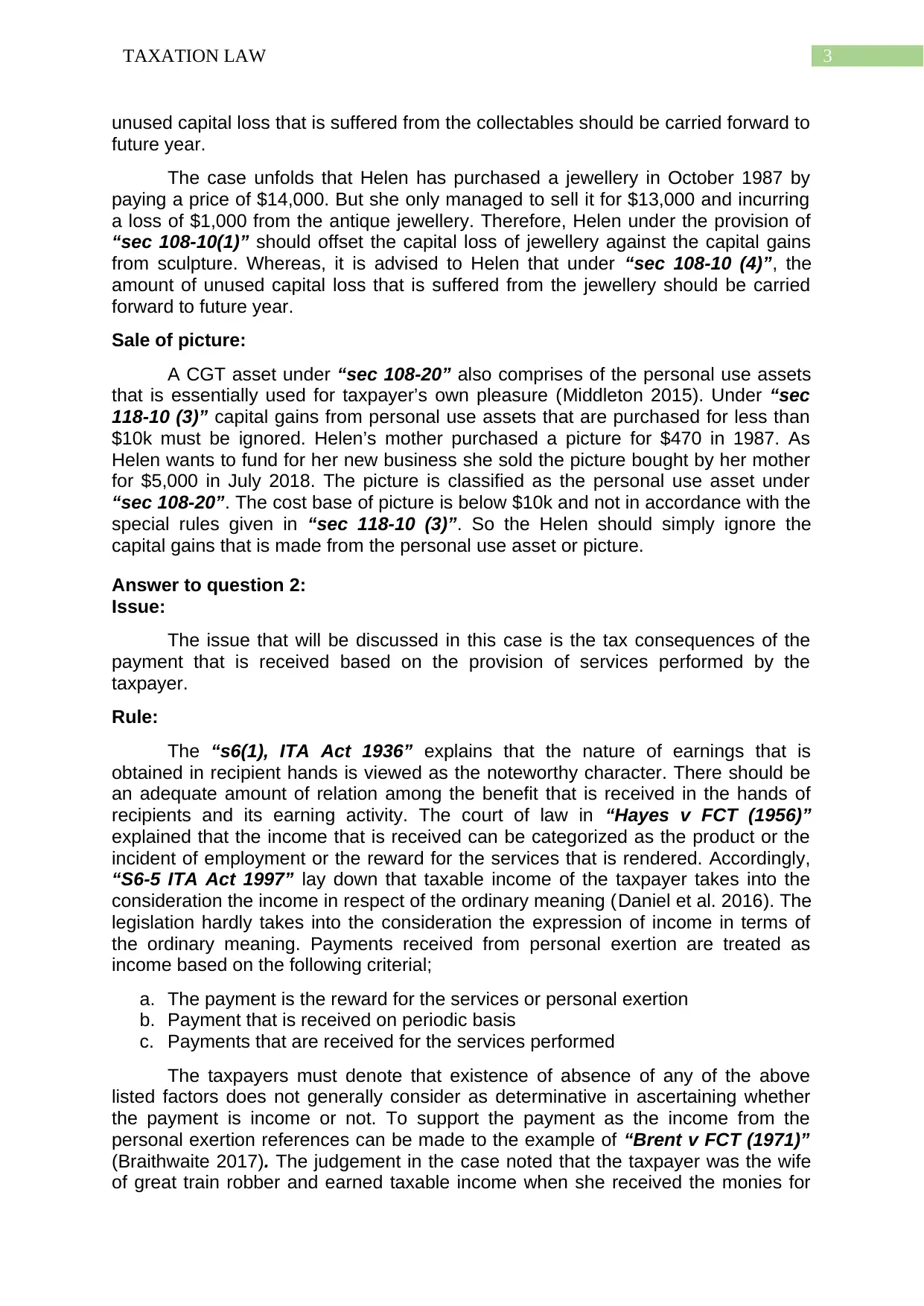
3TAXATION LAW
unused capital loss that is suffered from the collectables should be carried forward to
future year.
The case unfolds that Helen has purchased a jewellery in October 1987 by
paying a price of $14,000. But she only managed to sell it for $13,000 and incurring
a loss of $1,000 from the antique jewellery. Therefore, Helen under the provision of
“sec 108-10(1)” should offset the capital loss of jewellery against the capital gains
from sculpture. Whereas, it is advised to Helen that under “sec 108-10 (4)”, the
amount of unused capital loss that is suffered from the jewellery should be carried
forward to future year.
Sale of picture:
A CGT asset under “sec 108-20” also comprises of the personal use assets
that is essentially used for taxpayer’s own pleasure (Middleton 2015). Under “sec
118-10 (3)” capital gains from personal use assets that are purchased for less than
$10k must be ignored. Helen’s mother purchased a picture for $470 in 1987. As
Helen wants to fund for her new business she sold the picture bought by her mother
for $5,000 in July 2018. The picture is classified as the personal use asset under
“sec 108-20”. The cost base of picture is below $10k and not in accordance with the
special rules given in “sec 118-10 (3)”. So the Helen should simply ignore the
capital gains that is made from the personal use asset or picture.
Answer to question 2:
Issue:
The issue that will be discussed in this case is the tax consequences of the
payment that is received based on the provision of services performed by the
taxpayer.
Rule:
The “s6(1), ITA Act 1936” explains that the nature of earnings that is
obtained in recipient hands is viewed as the noteworthy character. There should be
an adequate amount of relation among the benefit that is received in the hands of
recipients and its earning activity. The court of law in “Hayes v FCT (1956)”
explained that the income that is received can be categorized as the product or the
incident of employment or the reward for the services that is rendered. Accordingly,
“S6-5 ITA Act 1997” lay down that taxable income of the taxpayer takes into the
consideration the income in respect of the ordinary meaning (Daniel et al. 2016). The
legislation hardly takes into the consideration the expression of income in terms of
the ordinary meaning. Payments received from personal exertion are treated as
income based on the following criterial;
a. The payment is the reward for the services or personal exertion
b. Payment that is received on periodic basis
c. Payments that are received for the services performed
The taxpayers must denote that existence of absence of any of the above
listed factors does not generally consider as determinative in ascertaining whether
the payment is income or not. To support the payment as the income from the
personal exertion references can be made to the example of “Brent v FCT (1971)”
(Braithwaite 2017). The judgement in the case noted that the taxpayer was the wife
of great train robber and earned taxable income when she received the monies for
unused capital loss that is suffered from the collectables should be carried forward to
future year.
The case unfolds that Helen has purchased a jewellery in October 1987 by
paying a price of $14,000. But she only managed to sell it for $13,000 and incurring
a loss of $1,000 from the antique jewellery. Therefore, Helen under the provision of
“sec 108-10(1)” should offset the capital loss of jewellery against the capital gains
from sculpture. Whereas, it is advised to Helen that under “sec 108-10 (4)”, the
amount of unused capital loss that is suffered from the jewellery should be carried
forward to future year.
Sale of picture:
A CGT asset under “sec 108-20” also comprises of the personal use assets
that is essentially used for taxpayer’s own pleasure (Middleton 2015). Under “sec
118-10 (3)” capital gains from personal use assets that are purchased for less than
$10k must be ignored. Helen’s mother purchased a picture for $470 in 1987. As
Helen wants to fund for her new business she sold the picture bought by her mother
for $5,000 in July 2018. The picture is classified as the personal use asset under
“sec 108-20”. The cost base of picture is below $10k and not in accordance with the
special rules given in “sec 118-10 (3)”. So the Helen should simply ignore the
capital gains that is made from the personal use asset or picture.
Answer to question 2:
Issue:
The issue that will be discussed in this case is the tax consequences of the
payment that is received based on the provision of services performed by the
taxpayer.
Rule:
The “s6(1), ITA Act 1936” explains that the nature of earnings that is
obtained in recipient hands is viewed as the noteworthy character. There should be
an adequate amount of relation among the benefit that is received in the hands of
recipients and its earning activity. The court of law in “Hayes v FCT (1956)”
explained that the income that is received can be categorized as the product or the
incident of employment or the reward for the services that is rendered. Accordingly,
“S6-5 ITA Act 1997” lay down that taxable income of the taxpayer takes into the
consideration the income in respect of the ordinary meaning (Daniel et al. 2016). The
legislation hardly takes into the consideration the expression of income in terms of
the ordinary meaning. Payments received from personal exertion are treated as
income based on the following criterial;
a. The payment is the reward for the services or personal exertion
b. Payment that is received on periodic basis
c. Payments that are received for the services performed
The taxpayers must denote that existence of absence of any of the above
listed factors does not generally consider as determinative in ascertaining whether
the payment is income or not. To support the payment as the income from the
personal exertion references can be made to the example of “Brent v FCT (1971)”
(Braithwaite 2017). The judgement in the case noted that the taxpayer was the wife
of great train robber and earned taxable income when she received the monies for
Paraphrase This Document
Need a fresh take? Get an instant paraphrase of this document with our AI Paraphraser
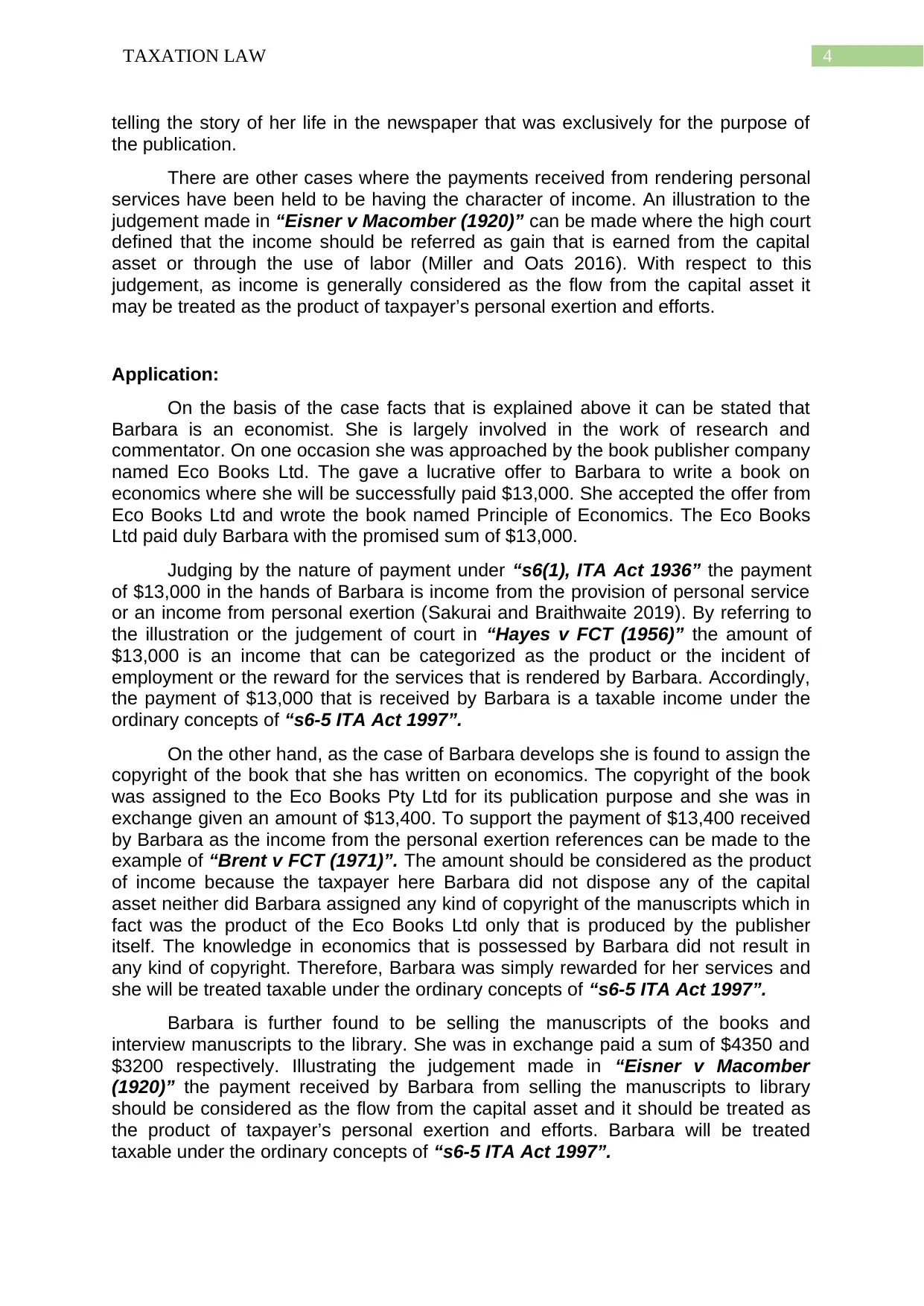
4TAXATION LAW
telling the story of her life in the newspaper that was exclusively for the purpose of
the publication.
There are other cases where the payments received from rendering personal
services have been held to be having the character of income. An illustration to the
judgement made in “Eisner v Macomber (1920)” can be made where the high court
defined that the income should be referred as gain that is earned from the capital
asset or through the use of labor (Miller and Oats 2016). With respect to this
judgement, as income is generally considered as the flow from the capital asset it
may be treated as the product of taxpayer’s personal exertion and efforts.
Application:
On the basis of the case facts that is explained above it can be stated that
Barbara is an economist. She is largely involved in the work of research and
commentator. On one occasion she was approached by the book publisher company
named Eco Books Ltd. The gave a lucrative offer to Barbara to write a book on
economics where she will be successfully paid $13,000. She accepted the offer from
Eco Books Ltd and wrote the book named Principle of Economics. The Eco Books
Ltd paid duly Barbara with the promised sum of $13,000.
Judging by the nature of payment under “s6(1), ITA Act 1936” the payment
of $13,000 in the hands of Barbara is income from the provision of personal service
or an income from personal exertion (Sakurai and Braithwaite 2019). By referring to
the illustration or the judgement of court in “Hayes v FCT (1956)” the amount of
$13,000 is an income that can be categorized as the product or the incident of
employment or the reward for the services that is rendered by Barbara. Accordingly,
the payment of $13,000 that is received by Barbara is a taxable income under the
ordinary concepts of “s6-5 ITA Act 1997”.
On the other hand, as the case of Barbara develops she is found to assign the
copyright of the book that she has written on economics. The copyright of the book
was assigned to the Eco Books Pty Ltd for its publication purpose and she was in
exchange given an amount of $13,400. To support the payment of $13,400 received
by Barbara as the income from the personal exertion references can be made to the
example of “Brent v FCT (1971)”. The amount should be considered as the product
of income because the taxpayer here Barbara did not dispose any of the capital
asset neither did Barbara assigned any kind of copyright of the manuscripts which in
fact was the product of the Eco Books Ltd only that is produced by the publisher
itself. The knowledge in economics that is possessed by Barbara did not result in
any kind of copyright. Therefore, Barbara was simply rewarded for her services and
she will be treated taxable under the ordinary concepts of “s6-5 ITA Act 1997”.
Barbara is further found to be selling the manuscripts of the books and
interview manuscripts to the library. She was in exchange paid a sum of $4350 and
$3200 respectively. Illustrating the judgement made in “Eisner v Macomber
(1920)” the payment received by Barbara from selling the manuscripts to library
should be considered as the flow from the capital asset and it should be treated as
the product of taxpayer’s personal exertion and efforts. Barbara will be treated
taxable under the ordinary concepts of “s6-5 ITA Act 1997”.
telling the story of her life in the newspaper that was exclusively for the purpose of
the publication.
There are other cases where the payments received from rendering personal
services have been held to be having the character of income. An illustration to the
judgement made in “Eisner v Macomber (1920)” can be made where the high court
defined that the income should be referred as gain that is earned from the capital
asset or through the use of labor (Miller and Oats 2016). With respect to this
judgement, as income is generally considered as the flow from the capital asset it
may be treated as the product of taxpayer’s personal exertion and efforts.
Application:
On the basis of the case facts that is explained above it can be stated that
Barbara is an economist. She is largely involved in the work of research and
commentator. On one occasion she was approached by the book publisher company
named Eco Books Ltd. The gave a lucrative offer to Barbara to write a book on
economics where she will be successfully paid $13,000. She accepted the offer from
Eco Books Ltd and wrote the book named Principle of Economics. The Eco Books
Ltd paid duly Barbara with the promised sum of $13,000.
Judging by the nature of payment under “s6(1), ITA Act 1936” the payment
of $13,000 in the hands of Barbara is income from the provision of personal service
or an income from personal exertion (Sakurai and Braithwaite 2019). By referring to
the illustration or the judgement of court in “Hayes v FCT (1956)” the amount of
$13,000 is an income that can be categorized as the product or the incident of
employment or the reward for the services that is rendered by Barbara. Accordingly,
the payment of $13,000 that is received by Barbara is a taxable income under the
ordinary concepts of “s6-5 ITA Act 1997”.
On the other hand, as the case of Barbara develops she is found to assign the
copyright of the book that she has written on economics. The copyright of the book
was assigned to the Eco Books Pty Ltd for its publication purpose and she was in
exchange given an amount of $13,400. To support the payment of $13,400 received
by Barbara as the income from the personal exertion references can be made to the
example of “Brent v FCT (1971)”. The amount should be considered as the product
of income because the taxpayer here Barbara did not dispose any of the capital
asset neither did Barbara assigned any kind of copyright of the manuscripts which in
fact was the product of the Eco Books Ltd only that is produced by the publisher
itself. The knowledge in economics that is possessed by Barbara did not result in
any kind of copyright. Therefore, Barbara was simply rewarded for her services and
she will be treated taxable under the ordinary concepts of “s6-5 ITA Act 1997”.
Barbara is further found to be selling the manuscripts of the books and
interview manuscripts to the library. She was in exchange paid a sum of $4350 and
$3200 respectively. Illustrating the judgement made in “Eisner v Macomber
(1920)” the payment received by Barbara from selling the manuscripts to library
should be considered as the flow from the capital asset and it should be treated as
the product of taxpayer’s personal exertion and efforts. Barbara will be treated
taxable under the ordinary concepts of “s6-5 ITA Act 1997”.
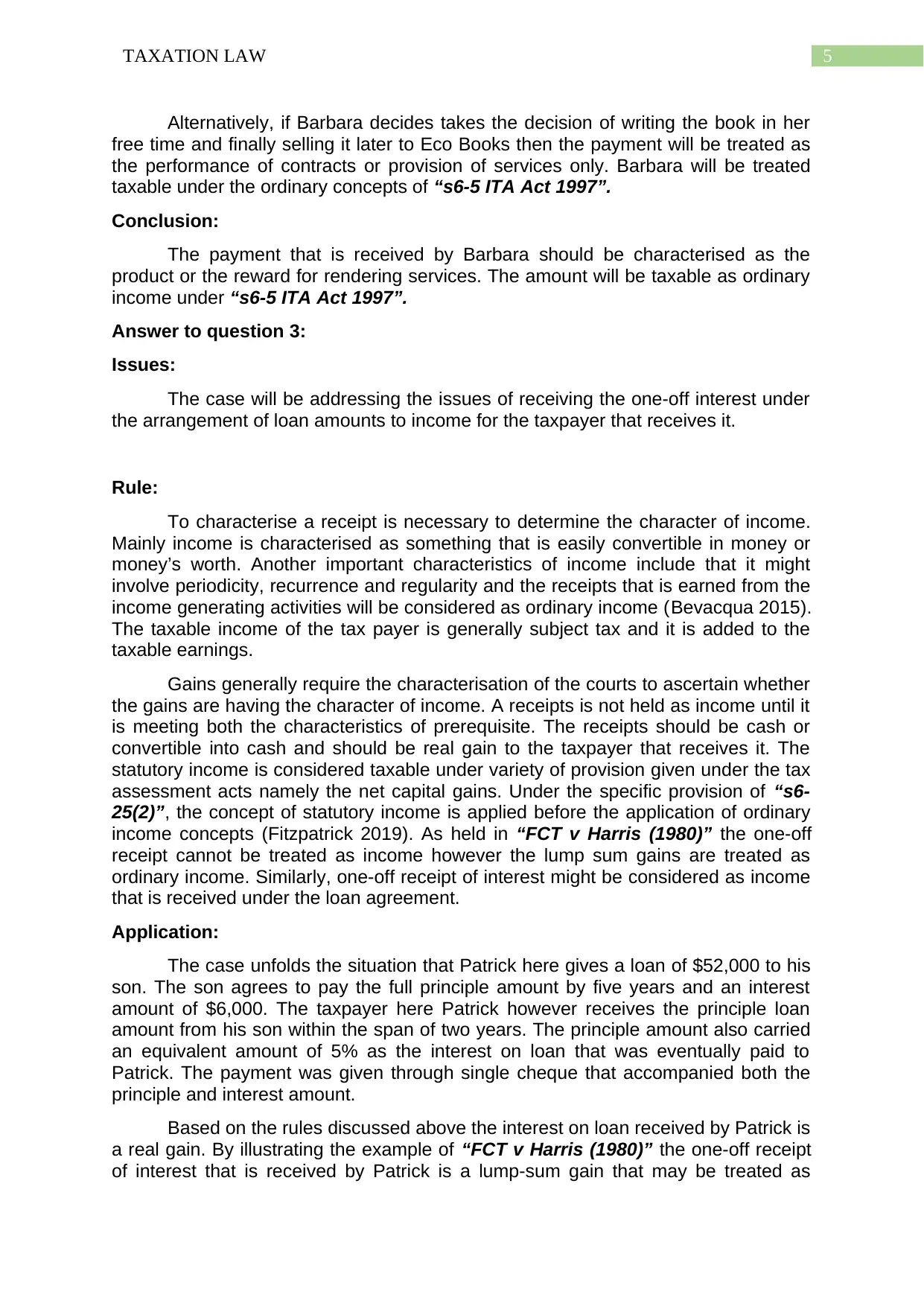
5TAXATION LAW
Alternatively, if Barbara decides takes the decision of writing the book in her
free time and finally selling it later to Eco Books then the payment will be treated as
the performance of contracts or provision of services only. Barbara will be treated
taxable under the ordinary concepts of “s6-5 ITA Act 1997”.
Conclusion:
The payment that is received by Barbara should be characterised as the
product or the reward for rendering services. The amount will be taxable as ordinary
income under “s6-5 ITA Act 1997”.
Answer to question 3:
Issues:
The case will be addressing the issues of receiving the one-off interest under
the arrangement of loan amounts to income for the taxpayer that receives it.
Rule:
To characterise a receipt is necessary to determine the character of income.
Mainly income is characterised as something that is easily convertible in money or
money’s worth. Another important characteristics of income include that it might
involve periodicity, recurrence and regularity and the receipts that is earned from the
income generating activities will be considered as ordinary income (Bevacqua 2015).
The taxable income of the tax payer is generally subject tax and it is added to the
taxable earnings.
Gains generally require the characterisation of the courts to ascertain whether
the gains are having the character of income. A receipts is not held as income until it
is meeting both the characteristics of prerequisite. The receipts should be cash or
convertible into cash and should be real gain to the taxpayer that receives it. The
statutory income is considered taxable under variety of provision given under the tax
assessment acts namely the net capital gains. Under the specific provision of “s6-
25(2)”, the concept of statutory income is applied before the application of ordinary
income concepts (Fitzpatrick 2019). As held in “FCT v Harris (1980)” the one-off
receipt cannot be treated as income however the lump sum gains are treated as
ordinary income. Similarly, one-off receipt of interest might be considered as income
that is received under the loan agreement.
Application:
The case unfolds the situation that Patrick here gives a loan of $52,000 to his
son. The son agrees to pay the full principle amount by five years and an interest
amount of $6,000. The taxpayer here Patrick however receives the principle loan
amount from his son within the span of two years. The principle amount also carried
an equivalent amount of 5% as the interest on loan that was eventually paid to
Patrick. The payment was given through single cheque that accompanied both the
principle and interest amount.
Based on the rules discussed above the interest on loan received by Patrick is
a real gain. By illustrating the example of “FCT v Harris (1980)” the one-off receipt
of interest that is received by Patrick is a lump-sum gain that may be treated as
Alternatively, if Barbara decides takes the decision of writing the book in her
free time and finally selling it later to Eco Books then the payment will be treated as
the performance of contracts or provision of services only. Barbara will be treated
taxable under the ordinary concepts of “s6-5 ITA Act 1997”.
Conclusion:
The payment that is received by Barbara should be characterised as the
product or the reward for rendering services. The amount will be taxable as ordinary
income under “s6-5 ITA Act 1997”.
Answer to question 3:
Issues:
The case will be addressing the issues of receiving the one-off interest under
the arrangement of loan amounts to income for the taxpayer that receives it.
Rule:
To characterise a receipt is necessary to determine the character of income.
Mainly income is characterised as something that is easily convertible in money or
money’s worth. Another important characteristics of income include that it might
involve periodicity, recurrence and regularity and the receipts that is earned from the
income generating activities will be considered as ordinary income (Bevacqua 2015).
The taxable income of the tax payer is generally subject tax and it is added to the
taxable earnings.
Gains generally require the characterisation of the courts to ascertain whether
the gains are having the character of income. A receipts is not held as income until it
is meeting both the characteristics of prerequisite. The receipts should be cash or
convertible into cash and should be real gain to the taxpayer that receives it. The
statutory income is considered taxable under variety of provision given under the tax
assessment acts namely the net capital gains. Under the specific provision of “s6-
25(2)”, the concept of statutory income is applied before the application of ordinary
income concepts (Fitzpatrick 2019). As held in “FCT v Harris (1980)” the one-off
receipt cannot be treated as income however the lump sum gains are treated as
ordinary income. Similarly, one-off receipt of interest might be considered as income
that is received under the loan agreement.
Application:
The case unfolds the situation that Patrick here gives a loan of $52,000 to his
son. The son agrees to pay the full principle amount by five years and an interest
amount of $6,000. The taxpayer here Patrick however receives the principle loan
amount from his son within the span of two years. The principle amount also carried
an equivalent amount of 5% as the interest on loan that was eventually paid to
Patrick. The payment was given through single cheque that accompanied both the
principle and interest amount.
Based on the rules discussed above the interest on loan received by Patrick is
a real gain. By illustrating the example of “FCT v Harris (1980)” the one-off receipt
of interest that is received by Patrick is a lump-sum gain that may be treated as
⊘ This is a preview!⊘
Do you want full access?
Subscribe today to unlock all pages.

Trusted by 1+ million students worldwide
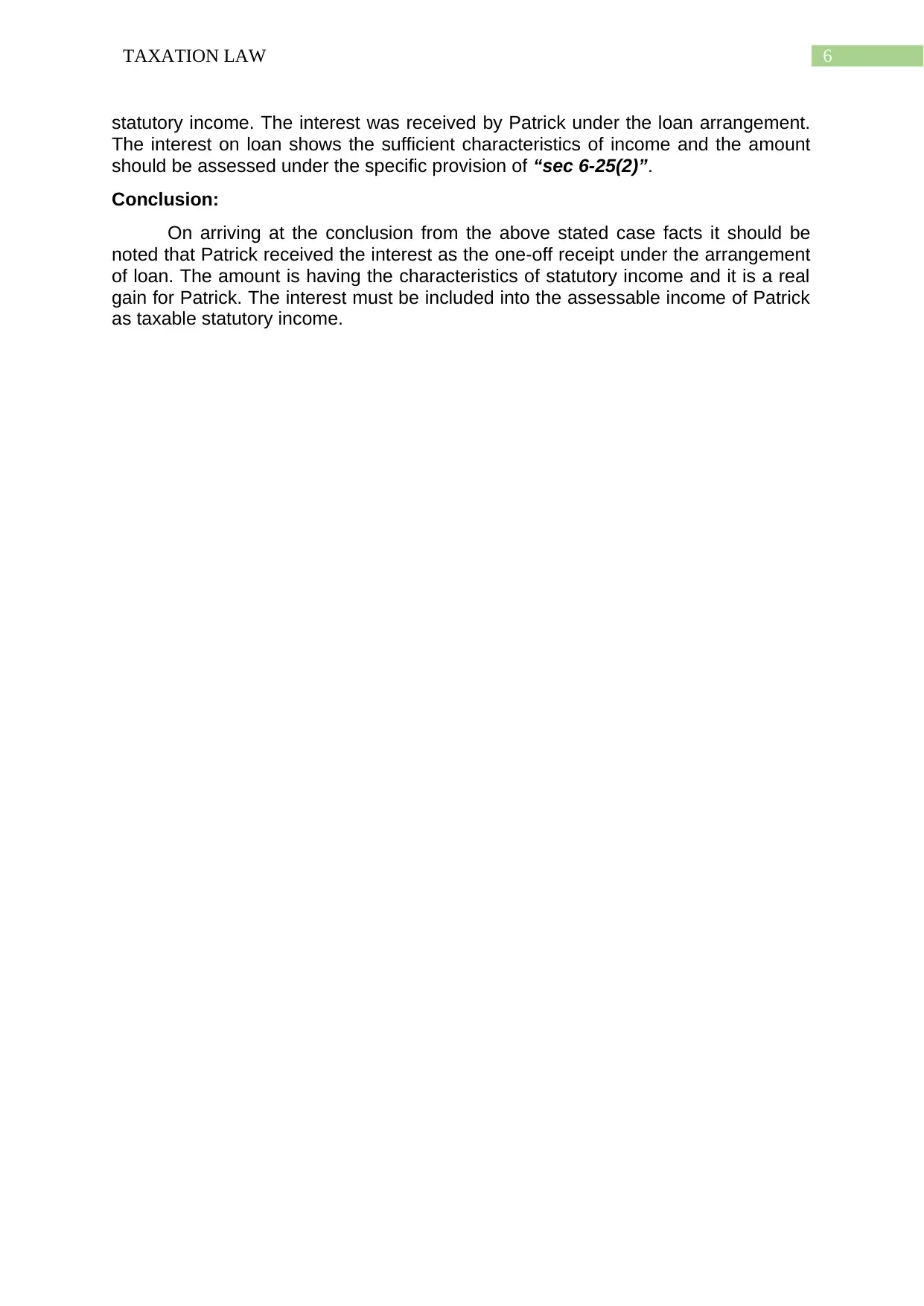
6TAXATION LAW
statutory income. The interest was received by Patrick under the loan arrangement.
The interest on loan shows the sufficient characteristics of income and the amount
should be assessed under the specific provision of “sec 6-25(2)”.
Conclusion:
On arriving at the conclusion from the above stated case facts it should be
noted that Patrick received the interest as the one-off receipt under the arrangement
of loan. The amount is having the characteristics of statutory income and it is a real
gain for Patrick. The interest must be included into the assessable income of Patrick
as taxable statutory income.
statutory income. The interest was received by Patrick under the loan arrangement.
The interest on loan shows the sufficient characteristics of income and the amount
should be assessed under the specific provision of “sec 6-25(2)”.
Conclusion:
On arriving at the conclusion from the above stated case facts it should be
noted that Patrick received the interest as the one-off receipt under the arrangement
of loan. The amount is having the characteristics of statutory income and it is a real
gain for Patrick. The interest must be included into the assessable income of Patrick
as taxable statutory income.
Paraphrase This Document
Need a fresh take? Get an instant paraphrase of this document with our AI Paraphraser
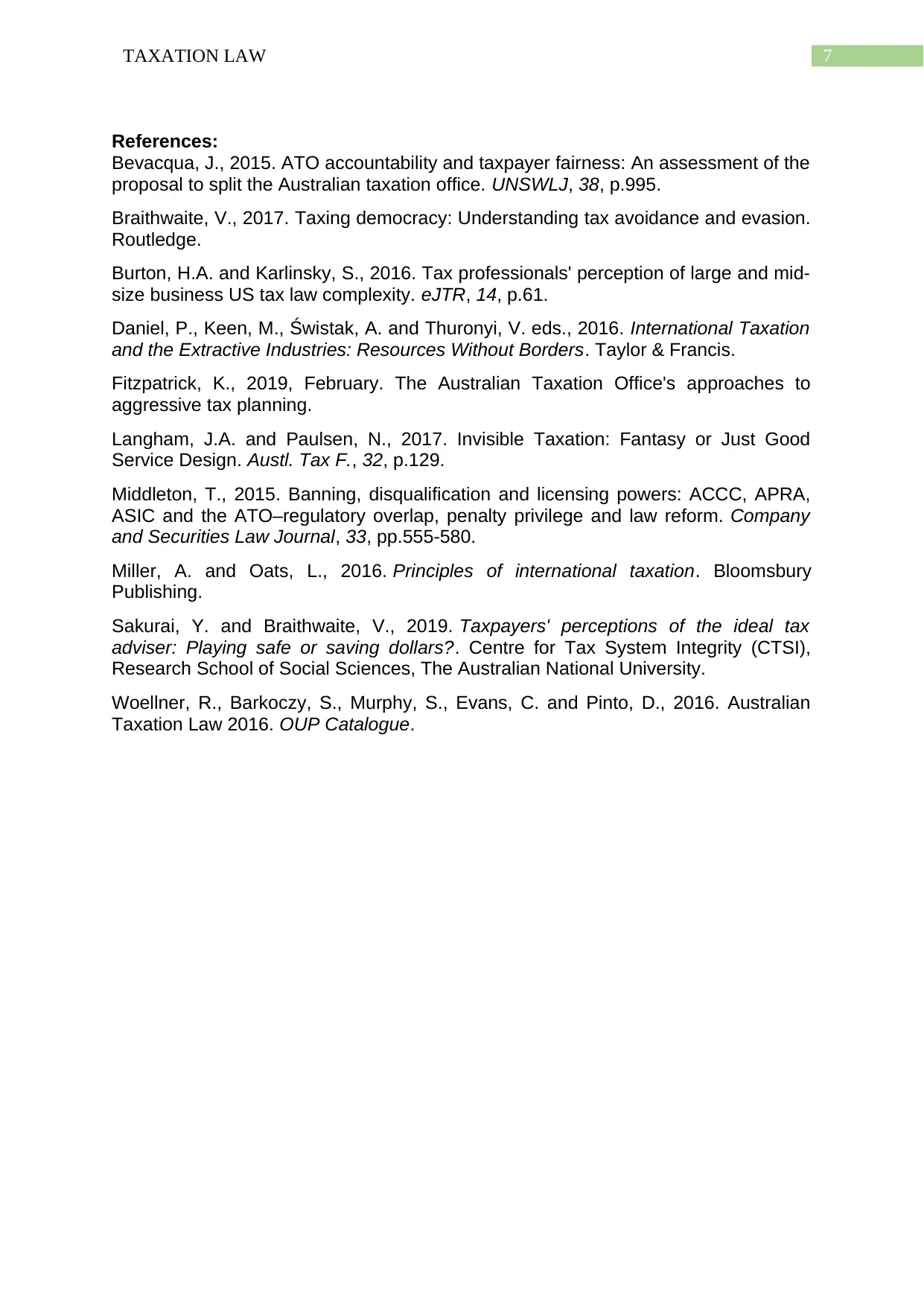
7TAXATION LAW
References:
Bevacqua, J., 2015. ATO accountability and taxpayer fairness: An assessment of the
proposal to split the Australian taxation office. UNSWLJ, 38, p.995.
Braithwaite, V., 2017. Taxing democracy: Understanding tax avoidance and evasion.
Routledge.
Burton, H.A. and Karlinsky, S., 2016. Tax professionals' perception of large and mid-
size business US tax law complexity. eJTR, 14, p.61.
Daniel, P., Keen, M., Świstak, A. and Thuronyi, V. eds., 2016. International Taxation
and the Extractive Industries: Resources Without Borders. Taylor & Francis.
Fitzpatrick, K., 2019, February. The Australian Taxation Office's approaches to
aggressive tax planning.
Langham, J.A. and Paulsen, N., 2017. Invisible Taxation: Fantasy or Just Good
Service Design. Austl. Tax F., 32, p.129.
Middleton, T., 2015. Banning, disqualification and licensing powers: ACCC, APRA,
ASIC and the ATO–regulatory overlap, penalty privilege and law reform. Company
and Securities Law Journal, 33, pp.555-580.
Miller, A. and Oats, L., 2016. Principles of international taxation. Bloomsbury
Publishing.
Sakurai, Y. and Braithwaite, V., 2019. Taxpayers' perceptions of the ideal tax
adviser: Playing safe or saving dollars?. Centre for Tax System Integrity (CTSI),
Research School of Social Sciences, The Australian National University.
Woellner, R., Barkoczy, S., Murphy, S., Evans, C. and Pinto, D., 2016. Australian
Taxation Law 2016. OUP Catalogue.
References:
Bevacqua, J., 2015. ATO accountability and taxpayer fairness: An assessment of the
proposal to split the Australian taxation office. UNSWLJ, 38, p.995.
Braithwaite, V., 2017. Taxing democracy: Understanding tax avoidance and evasion.
Routledge.
Burton, H.A. and Karlinsky, S., 2016. Tax professionals' perception of large and mid-
size business US tax law complexity. eJTR, 14, p.61.
Daniel, P., Keen, M., Świstak, A. and Thuronyi, V. eds., 2016. International Taxation
and the Extractive Industries: Resources Without Borders. Taylor & Francis.
Fitzpatrick, K., 2019, February. The Australian Taxation Office's approaches to
aggressive tax planning.
Langham, J.A. and Paulsen, N., 2017. Invisible Taxation: Fantasy or Just Good
Service Design. Austl. Tax F., 32, p.129.
Middleton, T., 2015. Banning, disqualification and licensing powers: ACCC, APRA,
ASIC and the ATO–regulatory overlap, penalty privilege and law reform. Company
and Securities Law Journal, 33, pp.555-580.
Miller, A. and Oats, L., 2016. Principles of international taxation. Bloomsbury
Publishing.
Sakurai, Y. and Braithwaite, V., 2019. Taxpayers' perceptions of the ideal tax
adviser: Playing safe or saving dollars?. Centre for Tax System Integrity (CTSI),
Research School of Social Sciences, The Australian National University.
Woellner, R., Barkoczy, S., Murphy, S., Evans, C. and Pinto, D., 2016. Australian
Taxation Law 2016. OUP Catalogue.
1 out of 8
Related Documents
Your All-in-One AI-Powered Toolkit for Academic Success.
+13062052269
info@desklib.com
Available 24*7 on WhatsApp / Email
![[object Object]](/_next/static/media/star-bottom.7253800d.svg)
Unlock your academic potential
Copyright © 2020–2025 A2Z Services. All Rights Reserved. Developed and managed by ZUCOL.




